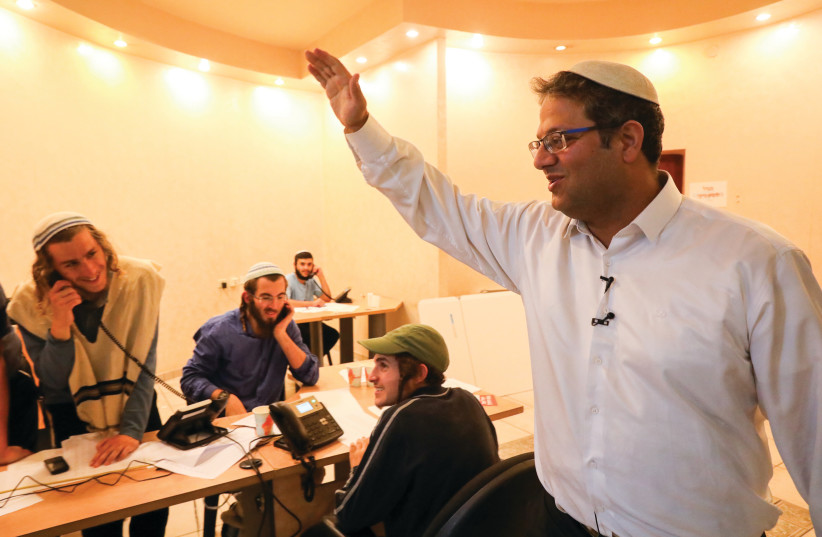
Remember the incredible mess in the Sheikh Jarrah neighborhood four weeks ago, after Palestinian residents burned a Jewish home? Yes, the story that brought MK Itamar Ben-Gvir rushing over to “open an office” and “protect the Jewish residents,” along with a handful of provocative Likud members who arrived to support the most extreme member of Knesset, and then ended with the expected twist: MKs Ofer Cassif and Ahmad Tibi who showed up to sprinkle some more fuel into the fire.
Hard to forget. And still – although the story stirred big headlines in Israel, as far as The New York Times was concerned, it never happened. Maybe someone there wasn’t too happy to report that Palestinians are capable of burning Jewish homes. It’s not part of the desired image.
After two months of my daily monitoring of all Israel-related headlines in the world’s most important newspaper, the emerging picture is clearer. The staff is clearly covering “the conflict,” but in effect, has only been paying attention to very specific stories in which only the Palestinian narrative is being presented, with Israel painted as “the villain.”
But the pro-Palestinian narrative is the easy part. The hard part is the information which seems to have been systematically discarded, and therefore simply hasn’t been reaching the readers. To be specific, 75% of the conflict-related headlines in Israel during these two months were not print-worthy to The New York Times.
February saw a total of eight stories about Israel on the Times’ site (homepage, opinion page, world page, and Middle East page), but an additional 24 stories which could have shed some more light on events in the region, ended up being silenced.

In total, 13 main headlines about violence and threats toward Israel from the West Bank, Hamas, Hezbollah and Syria, disappeared. Eleven more marginal stories about Palestinian violence, or violence toward Palestinians but by non-Israel parties, have been kept in the dark.
No terror attacks or drones
For the second month running, it’s incredible to realize that an enormous part of what took place here over the past weeks simply did not occur, as far as Times readers are concerned. Australia did not declare Hamas a terror organization, there were no soldiers shot near Nablus and no attempted shootings at buses.
There was no elimination of three terrorists in Nablus, no taxi driver who accidentally entered Nablus right at the time of the event and was nearly lynched, no attempted drone penetrations from Lebanon and Gaza. The Hezbollah UAV that penetrated Israeli territory, and set off civilian alarms on the Golan Heights, is a non-event. There were also no stone-throwing incidents anywhere.
The antisemitic Amnesty International report, which was broadly repudiated (and of course praised by Hamas), never existed for The New York Times. It also seems that Israeli operations in Syria, intended to prevent Iran from gaining a foothold on Israel’s narrow borders (according to foreign press) is of no interest to anyone.
Almost everything related to threats or attacks against Israel, is simply not reported. Israeli Arab journalist Khaled Abu Toameh reported that in January alone there were 623 anti-Israeli “resistance” actions by Palestinian elements, of which 28 involved shootings, and others involved stabbing and car-ramming.
Other stories in February also disappeared: a Hamas attempt to harm Israelis in the Philippines was thwarted; Turkey and Israel worked together to expel Hamas activists from Ankara; Palestinians illegally entered Israel from Gaza and set a truck on fire; and Hamas and Islamic Jihad commanders met with Hezbollah elements in Beirut to discuss “cooperation.”
Additionally, anything related to inter-Palestinian violence is simply not worth publishing, as far as Times is concerned. Qatar refused the Palestinian Authority’s request not to broadcast an Al-Jazeera program on human rights activist Nizar Banat, who was beaten to death by Palestinian security forces. Hamas arrested a number of “collaborators” with Israel and Lord only knows what those poor souls must be suffering in the dark cellars of the terrorist organization, if they’re even alive.
Supposedly, Palestinian human rights are the pure intentions behind this selective coverage – but The New York Times is simply not interested when Israel is not the guilty party.
Israel has been mentioned on the site 238 times since the beginning of the year. Hamas were mentioned seven times (and never described as a terror organization), Hezbollah was mentioned four times, and neither appeared in the headlines or sub-headlines. The ironic takeaway from this is that while Israel receives a great deal of criticism (56% of all mentions were negative), Hamas and Hezbollah receive none and can simply do as they please.
Distorted and misleading information
In contrast to all the stories that were silenced, the story of the Palestinian-American who was treated violently by the Netzach Yehuda unit and died of a heart attack received extensive coverage in January, as well as one more notice in February.
This was Israel’s first negative headline in NYT during the past month, quickly followed by the unavoidable report on the Pegasus spyware affair. It generated a negative headline, however it’s hard to complain when it was also the main story in Israel for a long while, until it was refuted.
Another headline, which discussed the growing settler violence on the West Bank, claimed that Palestinian violence was punished whereas settler violence was going unpunished. But nowhere was it mentioned that throughout the long years of the conflict, Palestinian violence had been much more extensive than settler violence.
Nor was it stated that Palestinian violence is feted and praised, including official payments to terrorists broadly distributed by the Palestinian Authority. Furthermore, the Times based its report on data gathered by the B’Tselem NGO, which has become an unreliable source and is no longer quoted by Israeli media.
But the harshest story about Israel in The New York Times in the past month was actually about a 26-year-old Jewish woman who was employed as a teacher by a synagogue with a pro-Israel agenda, and then fired. The teacher was interviewed at length about suing the synagogue for firing her “due to her beliefs.”
It turns out that during the conflict with Hamas in May 2021, she wrote a post in which she rejected Zionism, and blamed Israel for genocide. She wrote that she “rejects the Zionist claim to the land of Palestine,” that “Zionism is not a necessary component of Jewish identity,” and that Jewish institutions in the US are spreading one-sided propaganda about the conflict. Truthfully – the incredible part is that the above-mentioned Zionist synagogue hired her for the teaching position in the first place.
The 1,500-word article mainly addresses the legal rights of the ex-teacher, who is suing the synagogue, demanding to be rehired and paid damages. Since being let go after an employment of only two weeks, she claims that she has been unable to support herself or find work with the same social benefits. Her photograph appears at the head of the article, portraying her as a sad, innocent victim, attacked by utter villains. A true tragedy.
This young woman believes her rights to her “beliefs” were compromised, and perhaps this is the true tragedy: she has no idea that she has been nurtured by incorrect, misleading information. She does not understand that Zionism is very much an integral element of Jewish identity, and has been so throughout thousands of years of diaspora, in which generations upon generations of Jews murmured the prayer “Next year in a rebuilt Jerusalem.” The Times’ interviewers, of course, did not bother to correct her.
The entire article deals with the nature of the suit, and with the fact that many young Jews today don’t feel any emotional attachment to Israel. It quotes a survey that shows 25% of young Jews believe Israel is an “apartheid state” and 22% believe it is “committing genocide against the Palestinians.” Does it matter that these are complete lies, and not “opinions”?
The article further notes that Peter Beinart, a radical anti-Israeli Jew who often expresses his views in The New York Times, signed a petition along with 78 other activists, supporting this young woman, as they believe that she absolutely must return to her job as a Jewish educator.
Attacking the world’s most persecuted people
The tracking experience has become a bit frightening. It’s frightening because the Times shows a very clear support for Jews who are distancing themselves from any connection with Israel, and even believe it shouldn’t exist as a Jewish state.
It’s scary because nowhere does this long, meandering article mention that the “opinion” stating that Israel is guilty of genocide, is libel. It is simply a lie, unsupported by any data or fact. If this were about a private individual, the NYT would never dare to quote an interviewee without at least giving the accused the right to comment. This would be an absolutely justified cause for a libel suit.
It’s scary because it seems that The New York Times finds it very important to turn this young woman into a heroine and the justified party in the story. As if it were a crime for a pro-Israel synagogue to refuse to hire a teacher who outspokenly supports Hamas’ agenda.
It’s scary because the editorial stance is systematic and causes continuing damage to the glue which unifies the Jewish people – the most persecuted people on earth. There are only 15 million Jews in the world, most of whom are divided between Israel and the US, and the Times, for some reason, chooses to support their “right” to resent and split off from one another.
The continuous report is selective and lacking, thus creating a misleading picture of Israel as aggressive by nature and the Palestinians as never having done anything to anyone. In addition, false statements are quoted freely as “opinions” with not so much as a footnote to clarify.
This is not part of a legitimate debate; it’s slander. Add to this the fact that the editorial position is longstanding support for people like Beinart, in other words, preaching to cut off the ties between Zionism and Judaism. Tell me honestly – is this not a continuous attack on the future of Judaism as a whole?
The author is a writer for the Maariv newspaper and a blogger at HuffPost.







